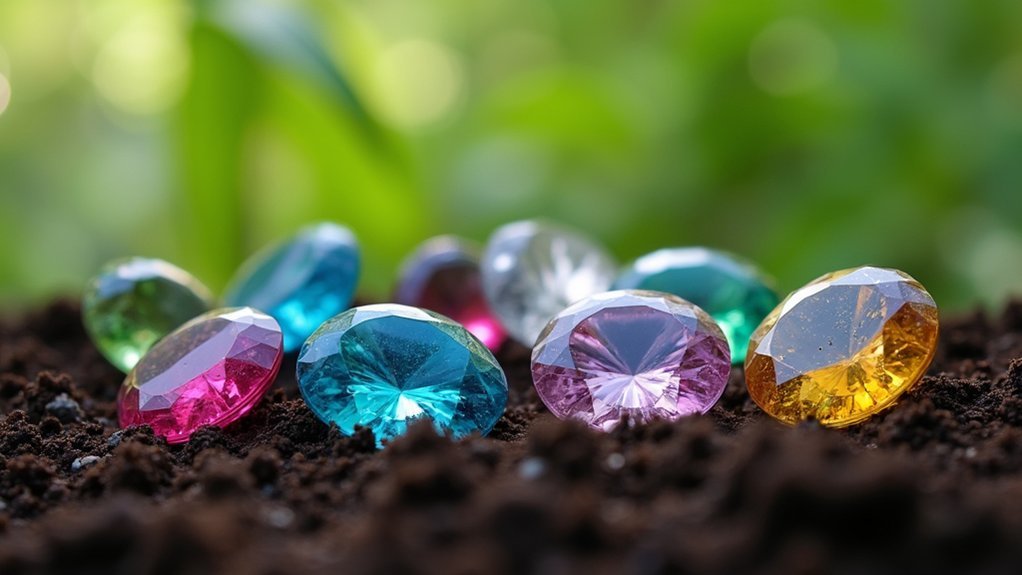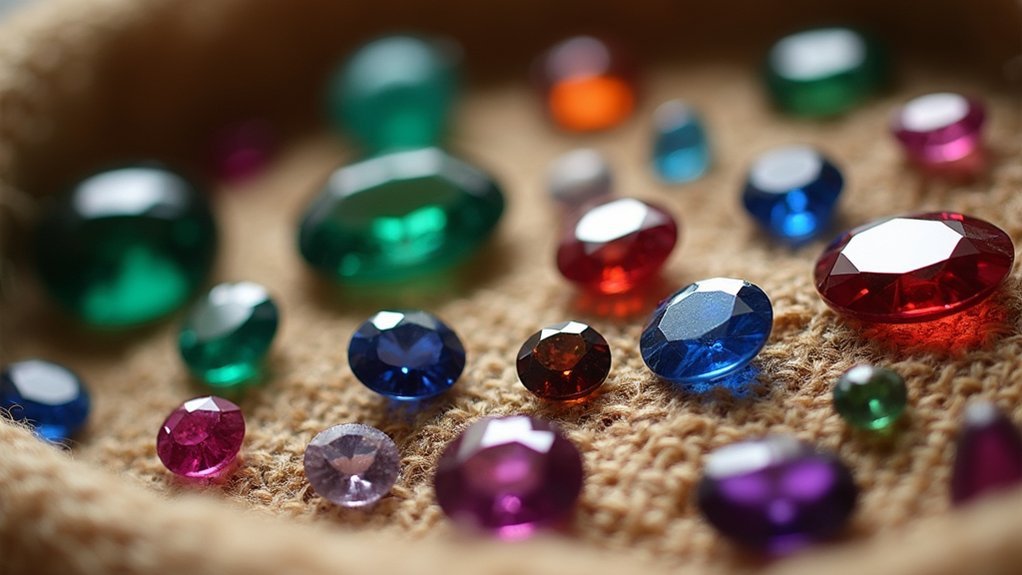You can trace your gemstone’s ethical journey by demanding complete documentation from mine to market, including provenance reports that verify conflict-free status and responsible extraction practices. Look for certifications from organizations like the Responsible Jewellery Council or Kimberley Process, which guarantee transparency standards are met. Consider lab-grown alternatives that eliminate environmental destruction while supporting ethical suppliers who prioritize worker treatment and environmental restoration. Understanding these verification methods will help you make informed purchasing decisions that align with your values.
Understanding the Path From Mine to Market

When you purchase a gemstone, you’re holding the final product of a complex journey that begins deep within the earth and travels through multiple hands before reaching your jewelry box.
Every gemstone carries the story of its underground origins and the countless skilled hands that shaped its journey to you.
This path involves miners extracting stones from the ground, where ethical sourcing practices determine whether workers receive fair treatment and environmental damage stays minimal.
You’ll find that traceability becomes essential as your gemstone moves through various intermediaries—cutters, polishers, dealers, and retailers. Each step requires documentation proving the stone’s conflict-free status and responsible origins.
When you choose gems backed by sustainable practices, you’re supporting land reclamation, proper waste management, and water conservation efforts that protect mining communities and their ecosystems throughout this intricate supply chain.
Conflict Gemstones and Their Global Impact
Behind the sparkle of certain gemstones lies a devastating reality—these precious stones often fund armed conflicts, human rights violations, and environmental destruction across the globe.
You’re witnessing how Myanmar’s gem mining directly finances military operations and ethnic cleansing campaigns. When you purchase stones from such regions, you’re unknowingly supporting systematic violence.
The 2021 U.S. sanctions against Myanmar’s gemstone companies demonstrate international recognition of these unethical practices. Historical examples like the Khmer Rouge’s sapphire-funded genocide reveal this isn’t new—it parallels the well-documented conflict diamonds crisis.
You’ll find that environmental harm accompanies these human rights abuses: contaminated waterways, deforestation, and dangerous mining pits devastate communities.
These conflict gemstones undermine sustainable development while perpetuating cycles of violence and ecological destruction.
Transparency Standards in Modern Gemstone Sourcing

Although conflict gemstones continue plaguing the industry, transparency standards are revolutionizing how you can verify your stones’ ethical origins.
When you’re shopping for gemstones, you can now access provenance reports that detail your stone’s complete journey from mine to market. These documents provide clear extraction and processing information you need to make informed decisions.
Certification systems like the Responsible Jewellery Council establish ethical practices guidelines and conduct regular audits throughout supply chains.
Professional certification bodies enforce rigorous ethical standards and perform ongoing supply chain audits to ensure gemstone industry accountability.
You’ll find frameworks such as the Kimberley Process Certification Scheme specifically target conflict diamond prevention.
Modern traceability initiatives empower you by encouraging brands to disclose their supply chains completely. This transparency lets you support responsible mining practices while confidently purchasing conflict-free gemstones that align with your values.
Environmental and Social Responsibility in Mining
While transparency standards help you identify ethical sources, the gemstone industry’s environmental and social impact extends far beyond supply chain documentation.
You’ll find that traditional gem mining devastates local environments through deforestation, water contamination, and unfilled pits that threaten community health. Fossil fuel-powered machinery worsens air pollution, while siltation destroys rivers and agricultural land.
However, you can support responsible mining practices that prioritize environmental restoration and land reclamation. Ethical operations minimize their footprint through sustainable extraction methods.
When you choose gems from companies supporting artisanal miners and fair trade initiatives, you’re promoting equitable practices that guarantee safe working conditions and fair wages. Your purchasing decisions directly influence whether the industry adopts more responsible approaches to gemstone extraction.
Lab-Grown Alternatives and Sustainable Options

Beyond supporting responsible mining practices, lab-grown gemstones offer you a revolutionary alternative that eliminates environmental destruction entirely.
These stones are created in controlled environments using advanced technology, producing visually flawless gems at more affordable prices than natural counterparts. You’ll avoid the ecological damage from traditional mining like deforestation and water contamination.
MiaDonna provides ethical jewelry featuring lab-grown sapphires, rubies, and emeralds that don’t compromise quality or beauty.
When you choose these sustainable options, you’re supporting responsible sourcing while helping mining-affected communities—MiaDonna donates at least 10% of profits to aid these populations.
You’ll also enjoy unlimited customization in sizes, shapes, and colors, creating unique jewelry designs that perfectly align with your personal values and aesthetic preferences.
Choosing Verified Ethical Gemstone Suppliers
When you’re ready to purchase ethical gemstones, you’ll need to identify suppliers who meet rigorous certification standards from organizations like the Responsible Jewellery Council.
You should prioritize companies that provide detailed transparency reports about their sourcing practices, labor conditions, and environmental impact.
Look for suppliers who submit to regular third-party audits, as this external verification guarantees they’re actually following through on their ethical commitments rather than just making claims.
Supplier Certification Standards
As you commence your ethical gemstone journey, choosing suppliers with proper certification standards becomes your most powerful tool for guaranteeing responsible sourcing.
Organizations like the Responsible Jewellery Council (RJC) establish supplier certification standards that guarantee adherence to ethical practices regarding labor rights, environmental protection, and community development.
When you select certified suppliers, you’re supporting fair trade principles that guarantee miners receive fair wages and work in safe conditions.
Regular audits maintain compliance and provide transparency throughout the sourcing process. Third-party verification systems build your confidence as a consumer, assuring you that gemstones are conflict-free.
Your choice to engage with certified suppliers directly empowers local communities through investments in education, healthcare, and sustainable economic development initiatives.
Transparency and Auditing
Building on these certification foundations, transparency and thorough auditing create the backbone of truly verified ethical gemstone suppliers.
When you’re choosing suppliers, you’ll want to prioritize those who openly share their supply chain information and submit to regular third-party audits.
Here’s what to look for in transparent suppliers:
- Detailed traceability reports that track stones from mine to market, revealing exact origins and handling processes
- Regular audit documentation from independent organizations verifying compliance with ethical sourcing standards
- Public transparency reports outlining labor conditions, environmental impacts, and community engagement efforts
These auditing practices guarantee you’re supporting suppliers who maintain accountability throughout their operations.
Frequently Asked Questions
How Do Gemstone Prices Change When Sourced Through Ethical Channels?
You’ll typically pay 10-30% more for ethically sourced gemstones due to fair labor practices, environmental standards, and transparent supply chains. However, you’re investing in sustainable mining that supports communities and reduces exploitation.
What Insurance Considerations Exist for Ethically Sourced Gemstones?
You’ll need documentation proving ethical sourcing for insurance coverage. Insurers may require certification from recognized organizations, detailed provenance records, and appraisals that factor in ethical premiums when determining replacement values.
Do Ethical Gemstones Require Special Care or Maintenance Procedures?
You don’t need special maintenance procedures for ethical gemstones. They’re identical to conventional stones chemically and physically, so you’ll follow standard cleaning, storage, and care practices based on each gemstone’s specific hardness and properties.
Can Consumers Verify Gemstone Authenticity Through Smartphone Apps or Technology?
You can’t reliably verify gemstone authenticity through smartphone apps alone. While some apps offer basic information, you’ll need professional gemological equipment and certified appraisers for accurate authentication and quality assessment.
What Legal Protections Exist for Consumers Purchasing Unethically Sourced Gemstones?
You’ll find minimal legal protections exist for unethically sourced gemstone purchases. Consumer protection laws rarely address sourcing ethics specifically. You’re mostly relying on voluntary industry standards, retailer policies, and limited conflict mineral regulations.
In Summary
You’ve now got the knowledge to make informed gemstone choices. When you’re shopping, you’ll ask the right questions about origins, certifications, and mining practices. You can confidently choose suppliers who prioritize transparency and ethical sourcing. Whether you opt for traditionally mined stones with proper documentation or lab-grown alternatives, you’re contributing to positive change in the industry. Your purchasing decisions directly support responsible practices and help eliminate harmful mining operations worldwide.





Leave a Reply